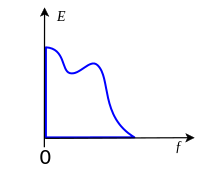Our website is made possible by displaying online advertisements to our visitors.
Please consider supporting us by disabling your ad blocker.
Baseband

In telecommunications and signal processing, baseband is the range of frequencies occupied by a signal that has not been modulated to higher frequencies.[1] Baseband signals typically originate from transducers, converting some other variable into an electrical signal. For example, the electronic output of a microphone is a baseband signal that is analogous to the applied voice audio. In conventional analog radio broadcasting, the baseband audio signal is used to modulate an RF carrier signal of a much higher frequency.
A baseband signal may have frequency components going all the way down to the DC bias, or at least it will have a high ratio bandwidth. A modulated baseband signal is called a passband signal. This occupies a higher range of frequencies and has a lower ratio and fractional bandwidth.
- ^ Jeff Rutenbeck, Tech Terms: What Every Telecommunications and Digital Media Professional Should Know, p. 24, CRC Press, 2012 ISBN 1136034501
Previous Page Next Page


